Key takeaways:
- Understanding cultural etiquette enhances relationships and fosters mutual respect, illustrated by experiences in various countries, such as India and Japan.
- Adapting to local customs, such as the Japanese practice of removing shoes and the Thai “wai” greeting, enriches cross-cultural interactions.
- Active listening and awareness of non-verbal cues are crucial for effective communication, as demonstrated in business settings in Japan and casual interactions in Italy.
- A willingness to ask questions and show curiosity can lead to deeper connections and understanding of local customs and traditions.
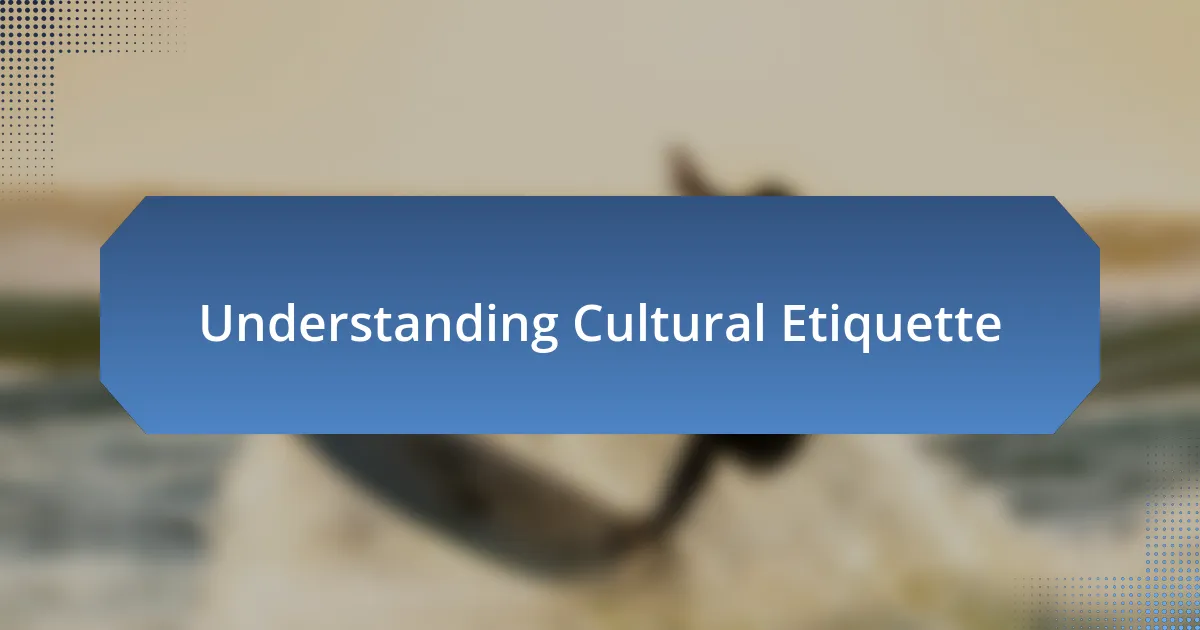
Understanding Cultural Etiquette
Cultural etiquette can sometimes feel elusive, especially when navigating diverse settings. I remember attending a vibrant wedding in India, where I was unsure if shaking hands was appropriate or if I should bow instead. That moment made me realize how understanding these nuances can foster deeper connections and mutual respect.
Have you ever found yourself in a situation where you felt out of place? I distinctly recall a dinner in Japan, where I hesitated to use chopsticks. Observing how everyone else maneuvered them with grace highlighted my own cultural ignorance. This experience taught me that etiquette isn’t just about following rules; it’s about showing appreciation and awareness of others’ traditions.
A genuine interest in learning about different customs can go a long way. For instance, I’ve made it a point to study common greetings from various cultures before traveling. This small step made my interactions more meaningful and opened doors to friendships that I might have missed otherwise. Understanding cultural etiquette is really about embracing the beauty of diversity and being willing to adapt and grow as individuals.
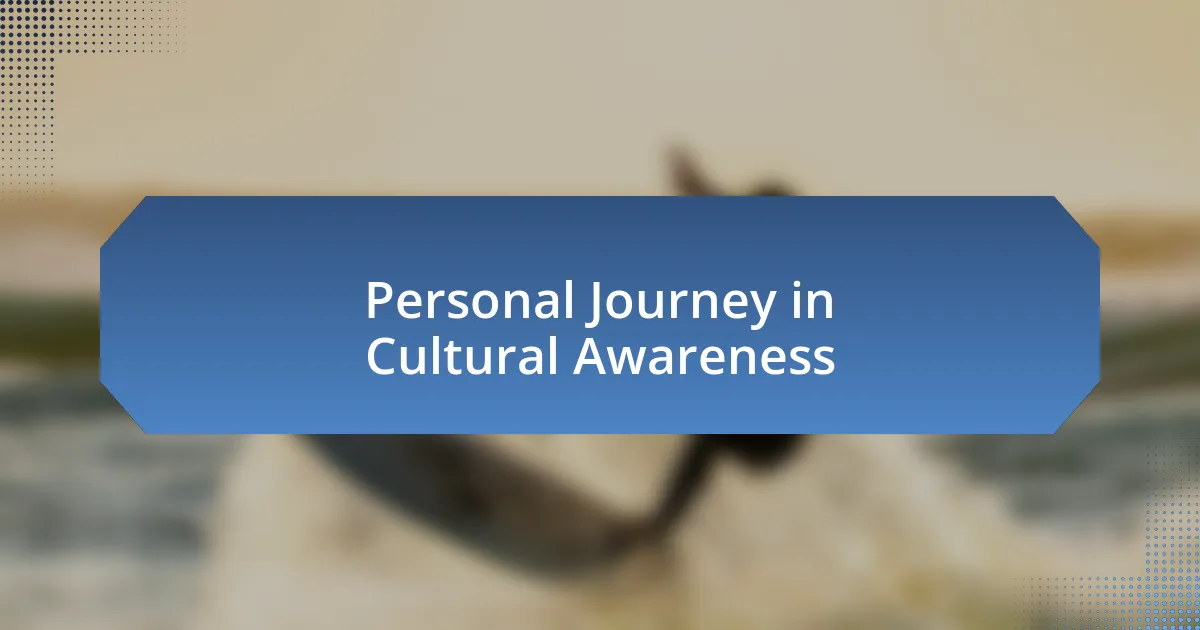
Personal Journey in Cultural Awareness
Navigating cultural awareness has been a deeply enriching journey for me. I vividly remember attending a family gathering in Brazil, where the warm embraces and lively interactions overwhelmed me. Initially, I felt a bit hesitant because my background was more reserved. However, as I immersed myself in the atmosphere, I found the importance of personal connections in different cultures, which eventually changed my view on expressing warmth and openness.
Another time, I found myself in a business meeting in Germany. I was surprised by how direct communication was respected there. In my home country, subtleties often play a crucial role in communication. The contrast made me appreciate the idea of clarity and efficiency, teaching me that being straightforward can enhance professional relationships. The experience opened my eyes to the power of transparency in fostering trust.
Traveling to various countries is not just about visiting landmarks; it’s about learning to navigate cultural landscapes. I once spent time in Thailand, where I learned the significance of the “wai” greeting. At first, I was unsure how to perform it correctly. With a bit of practice and willingness to embrace this custom, I felt a sense of belonging. Understanding regional customs takes time, but those efforts often lead to richer, more memorable experiences.
| Situation | Experience |
|---|---|
| Brazilian Family Gathering | Embracing warmth and openness |
| Business Meeting in Germany | Learning the value of direct communication |
| Visiting Thailand | Understanding and performing the “wai” greeting |
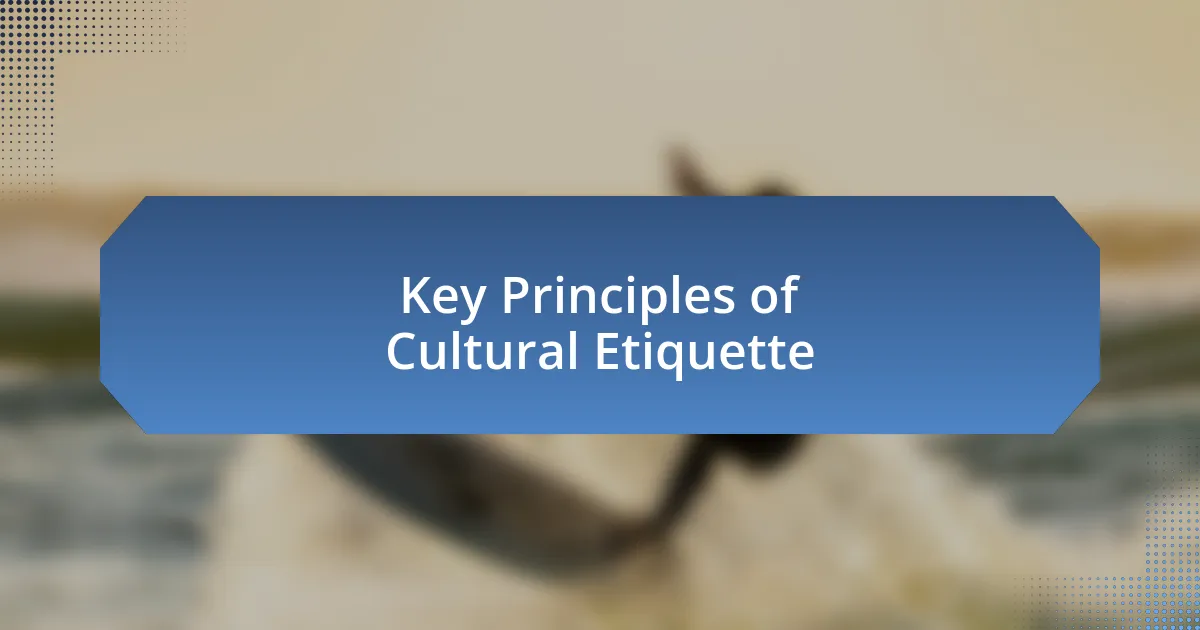
Key Principles of Cultural Etiquette
Cultural etiquette is a fascinating area, intricately woven into the fabric of every society. One key principle I’ve come to value is the importance of adapting to local customs. For instance, while visiting Japan, I was caught off guard by the practice of removing shoes before entering a home. Initially, I felt awkward, but as I observed others, I realized this small gesture reflected profound respect for the space and the people who live there. Embracing such customs deepened my connection with the locals, enriching my overall experience.
Here are some essential principles of cultural etiquette that I’ve learned:
- Respect for Traditions: Always take the time to learn about local customs and norms before visiting a new culture. This shows appreciation and curiosity.
- Non-Verbal Cues: Be aware that gestures, body language, and facial expressions can have different meanings in various cultures. I remember mistakenly giving a thumbs up in a country where it was considered offensive.
- Listening Skills: Practicing active listening is crucial. This includes not interrupting and allowing others to express their thoughts completely.
- Politeness and Formality: Understand the appropriate levels of politeness required; in many places, this impacts how relationships are formed.
- Gift Giving: In some cultures, the nature and presentation of a gift can carry significant meaning. I once learned that wrapping paper color mattered deeply in a culture, which made me rethink how I approach gift giving.
Each of these principles has contributed to my own journey of becoming more culturally aware and respectful.
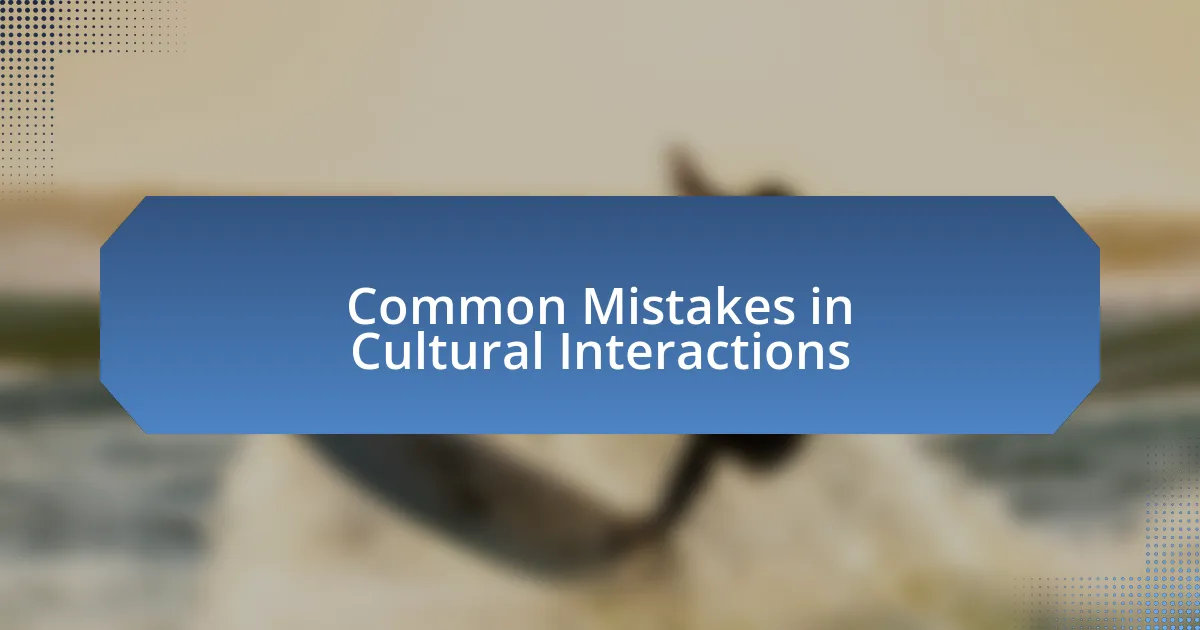
Common Mistakes in Cultural Interactions
In my travels, I’ve often witnessed the mistake of assuming that everyone shares the same values and societal norms. Take, for example, my experience in the Middle East, where I didn’t initially recognize the importance of modest dress. I quickly learned that what I thought was casual attire could inadvertently be seen as disrespectful. Doesn’t it make you think about how our own comfortable standards can sometimes clash with local values?
Another significant misstep I’ve observed is overlooking the importance of personal space. In Latin America, I found that standing close during conversations is the norm, but I initially felt overwhelmed. This discomfort led me to withdraw, yet as I embraced the closeness, I discovered it fostered warmth and connection. Isn’t it interesting how adapting our boundaries can open us to deeper relationships?
Lastly, I’ve seen people underestimate the power of context in communication. I remember a particularly awkward dinner where I misread a local’s humor, leading to confusion and discomfort at the table. It reinforced my belief that understanding nuances can make or break interactions. Have you ever felt that shift when you finally grasped the subtle cues? It’s those moments that remind us of the richness that cultural awareness brings to our interactions.

Tips for Successful Communication
In my experience, active listening is one of the most crucial components of successful communication, especially in multicultural settings. I vividly recall a business meeting in Japan, where silence was often used to convey thoughtfulness. Initially, I felt the urge to fill the gaps with chatter, but I quickly learned that pausing allowed for deeper understanding and respect. Isn’t it amazing how embracing silence can actually strengthen connections?
Another tip I’ve found invaluable is to be mindful of non-verbal cues. During a trip to Italy, I noticed how gestures and facial expressions often conveyed as much as words. I once misinterpreted an enthusiastic hand movement as aggression, only to realize it was a sign of excitement. This experience taught me to pay attention to body language as a vital part of the conversation. How often do we overlook these subtle signals that express a wealth of information?
Finally, adapting your language and tone can significantly enhance communication. I remember teaching English in Thailand, where I had to adjust my vocabulary and speaking speed to match my students’ understanding. At first, I was frustrated by the language barrier, but then I considered my audience and slowly saw their engagement grow. Isn’t it rewarding to see how a little flexibility can bridge gaps and foster learning?
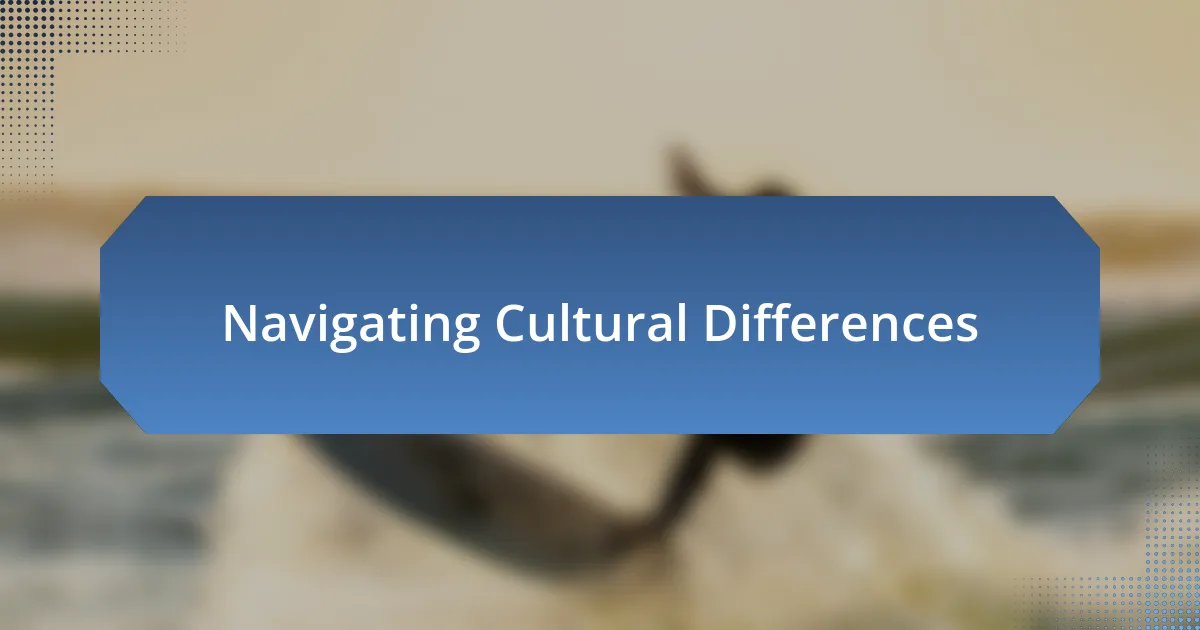
Navigating Cultural Differences
Navigating cultural differences can sometimes feel like walking a tightrope. I remember attending a wedding in India, where the vibrant customs left me both exhilarated and bewildered. At first, I hesitated to join the colorful festivities, feeling unsure if my presence would be welcome. However, as I embraced the celebrations, participating in the rituals, I found that my willingness to engage was met with warmth and acceptance. It’s incredible how opening oneself to new experiences can lead to connections that transcend cultural boundaries.
In my travels, I’ve also learned that understanding local customs requires a keen observation of the environment. Once, while visiting a new country, I noticed how people greeted each other with elaborate handshakes and expressions of warmth. At first, I defaulted to a simple nod, thinking it would suffice, but I soon realized that failing to reciprocate the local greeting diluted my attempts at making a genuine connection. This taught me that minor adjustments in how I relate to others can create significant bridges. Have you ever felt the impact of a small change in your approach?
Furthermore, asking questions is a powerful tool I’ve come to cherish. On my first trip to Brazil, I bravely approached a local market vendor to ask about traditional foods. My simple inquiry transformed our conversation into a delightful exchange, where he passionately shared stories behind each dish. This moment underscored for me how curiosity not only enriches our understanding of other cultures but also helps break down barriers. How many stories have you missed by not asking the right questions?

Reflecting on My Experiences
Reflecting on my experiences often unveils layers of understanding that I didn’t recognize in the moment. I distinctly recall a business meeting in Japan, where silence played a pivotal role in communication. Initially, the quiet left me feeling anxious, but over time, I grasped that pauses were not awkward; they were a sign of contemplation and respect. Embracing this nuance transformed my approach to negotiations, deepening my appreciation for the subtleties of cross-cultural dialogue.
There was also a poignant moment during my trip to Morocco when I realized how gestures can carry profound meanings. I innocently offered my left hand for a greeting, only to receive a polite but firm refusal. The local custom dictated that the right hand holds significance in their culture. That moment taught me the importance of learning about and respecting everyday gestures. Have you ever felt embarrassed by a simple misunderstanding that taught you a valuable lesson?
In reflecting on these experiences, I often think about how cultural etiquette can feel like a dance; it requires attention and intuition. Each misstep can lead to laughter or deeper learning. I recall laughing off a blunder during a dinner in Italy when I mistakenly served myself before the guests. The host kindly corrected me, and in that moment of humility, I learned that being open to correction fosters genuine friendships. Isn’t it fascinating how our experiences shape not only our understanding but also our ability to connect with others?


